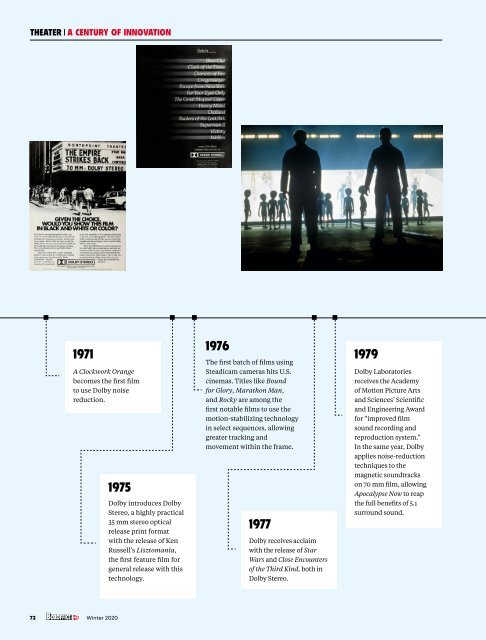Boxoffice Pro - Winter 2020
Boxoffice Pro is the official publication of the National Association of Theatre Owners
Boxoffice Pro is the official publication of the National Association of Theatre Owners
Create successful ePaper yourself
Turn your PDF publications into a flip-book with our unique Google optimized e-Paper software.
THEATER A CENTURY OF INNOVATION<br />
1971<br />
A Clockwork Orange<br />
becomes the first film<br />
to use Dolby noise<br />
reduction.<br />
1975<br />
Dolby introduces Dolby<br />
Stereo, a highly practical<br />
35 mm stereo optical<br />
release print format<br />
with the release of Ken<br />
Russell’s Lisztomania,<br />
the first feature film for<br />
general release with this<br />
technology.<br />
1976<br />
The first batch of films using<br />
Steadicam cameras hits U.S.<br />
cinemas. Titles like Bound<br />
for Glory, Marathon Man,<br />
and Rocky are among the<br />
first notable films to use the<br />
motion-stabilizing technology<br />
in select sequences, allowing<br />
greater tracking and<br />
movement within the frame.<br />
1977<br />
Dolby receives acclaim<br />
with the release of Star<br />
Wars and Close Encounters<br />
of the Third Kind, both in<br />
Dolby Stereo.<br />
1979<br />
Dolby Laboratories<br />
receives the Academy<br />
of Motion Picture Arts<br />
and Sciences’ Scientific<br />
and Engineering Award<br />
for “improved film<br />
sound recording and<br />
reproduction system.”<br />
In the same year, Dolby<br />
applies noise-reduction<br />
techniques to the<br />
magnetic soundtracks<br />
on 70 mm film, allowing<br />
Apocalypse Now to reap<br />
the full benefits of 5.1<br />
surround sound.<br />
72 <strong>Winter</strong> <strong>2020</strong>

















